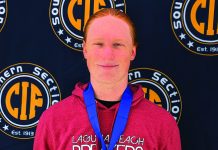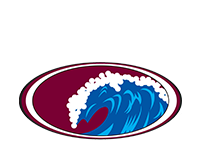The Indomitable Ian Cairns
 When I learned Ian Cairns was inducted into the Surfing Hall of Fame and Walk of Fame, both at prominent Huntington Beach surf shops last Thursday, I thought, “He wasn’t already in it?”
When I learned Ian Cairns was inducted into the Surfing Hall of Fame and Walk of Fame, both at prominent Huntington Beach surf shops last Thursday, I thought, “He wasn’t already in it?”
Cairns, of Laguna Beach, is one of the most influential talents in competitive surfing. His pupil of the last three years, Brett Simpson, shocked the surfing world last week by winning surfing’s largest prize, $100,000, for the second time in a row, at the U.S. Open in Huntington Beach. When I asked Cairns the odds of accomplishing this incredibly unlikely feat, he deadpanned, “Good.”
He was one of a group of Australians who showed up in Hawaii in the 1970s, the epicenter of serious surfing, hell-bent on making surfing a professional sport by being more exciting, more brash, and simply surfing better than anyone else, including the Hawaiians, on their own turf.
“It was a coup d’etat where Australia took over surfing,” said Drew Kampion, former Surfer Magazine editor, in “Busting Down the Door,” a movie about Cairns and his contemporaries. Their movement ignited a new wave of surfing popularity, but also hostility among the locals.
Cairns, at home in big surf, went on a tear, winning the 1973 Smirnoff Pro over local hero Jeff Hakman, the 1975 Duke Kahanamoku Classic in 25 foot surf at Waimea Bay, calling his group the Bronzed Aussies, and publishing some inflammatory essays in international surfing publications, including a column titled, “Aloha is dead.”
He described the rock-star attitude and matching jump suits the Aussies took to a press conference, an attempt at satire that didn’t translate well with the Hawaiians. When he returned to Hawaii for the 1976 big wave season, Cairns learned there was a contract out on his life, literally, but he saw his dream waiting on the other side of a tough winter. He went surfing with a baseball bat in his board bag on the beach, and a loaded shotgun in his car.
He intended to seriously injure the next person that tried to jump him. “That’s where my head was at.”
As a testament to his mental tenacity – and the modest state of pro surfing – Cairns was the highest earning pro surfer in the world that year, amassing $8000.
 Ultimately things with the Hawaiians resolved, and in 1978 the IPS, the world’s first professional surfing tour was born. Though tainted by disorganization and rule-bending, according to Cairns, he placed second overall behind inaugural world champ and fellow Bronzed Aussie Peter Townend.
Ultimately things with the Hawaiians resolved, and in 1978 the IPS, the world’s first professional surfing tour was born. Though tainted by disorganization and rule-bending, according to Cairns, he placed second overall behind inaugural world champ and fellow Bronzed Aussie Peter Townend.
That same year, Cairns earned $50,000 surfing in the movie “Big Wednesday,” for Gary Busey’s character “Leroy the Masochist.”
Already shifting careers by 1981, Cairns collaborated with Townend to launch the National Scholastic Surfing Association, an amateur platform from which almost all top pros have since graduated, including Tom Curren, Kelly Slater, Dane Reynolds, and Laguna surfer Alisa Schwarzstein. Cairns, then NSSA director, traveled with and coached the National Team, for which Schwarzstein brought home the world amateur title as a 15 year old. She went pro in 1984.
Cairns, firmly established as coach to surfing’s best and brightest, launched the Association of Surfing Professionals in 1983, still the major governing body of the sport today.
Cairns drew ideas from the Association of Tennis Professionals, Formula One racing, and other organized sports, and literally wrote the rulebook. He introduced the priority buoy, and real time scoring after each wave, which greatly expanded a competitor’s ability to strategize mid-heat. He also enlisted the legal help of Schwarzstein’s father Richard, a lawyer from New York and a Haitian art collector.
“He has been innovative and is the one putting surfing on a professional level, a business-like level, and having all the attributes needed to make it a world recognized event,” said Schwarzstein.
Cairns came up with the concept for a mega contest in Huntington Beach and sold it to sportswear maker Ocean Pacific. As a testament to his business acumen, Cairns retained ownership of the event, despite sponsorship ups and downs, which later morphed into to the U.S. Open. It’s considered the super bowl of surfing not because of the waves, but because of the corporate sponsorships. The stadium-like Huntington pier was the venue for rivalries like Occy vs. Curren, whose clashes became the stuff of competitive surfing legend: the greatest regular against the greatest goofy foot of the ‘80s, both dripping with style and power, doing for surf fans what neon did for surf apparel.
When the contest boiled over into riots in 1986, Cairns quit, moved back to Australia and began farming. Schwarzstein placed fourth on the women’s world tour that year. After grasshoppers devoured Cairns’ farm, he returned to head up the Bud Pro Tour, a domestic pro surfing series that served as an aspirant surfer’s entryway to the ASP world tour.
In 1992, Cairns was divorced from his wife of 20 years, Pat, with whom he has two children. As the Bud Tour took off, Cairns was back in Laguna Beach, and in contact with Alisa Schwarzstein again. They married in 1996.
“He was looking for a new start in America, and a new romance. It kind of came to a shock to us that he thought of this young girl, who was now a young lady was ready for a romance. It had a happy ending now that they have twin boys who love sports and one of them has taken really well to surfing and skateboarding. That has given them a lot of pride,” said Richard Schwarzstein.
After overseeing the development of a veritable who’s who of modern pro surfing, Cairns serves as head coach for Surfing America in 2009 and the team promptly won their first international title since 1996. In addition to Simpson, he coached Sage Erickson, who won the girls Pro Junior at this year’s U.S. Open as well.
Cairns outlines three areas he focuses on with his pupils: surfing skills, strategy, and desire to win.
He said, “I have a lot of understanding of these elements. I also picture a vision in my head of how they would be if they were perfect, and try and push them towards that level.”




